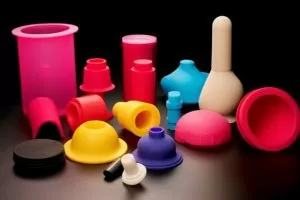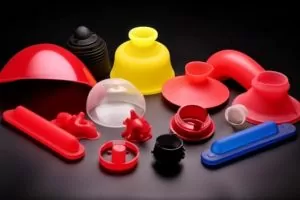Introduction
Silicone rubber compression molding is an effective process used to produce an array of silicone rubber products. This method involves filling an uncured silicone rubber material into a heated mold cavity and applying pressure with an appropriate tool, then cooling the mold so the material can cure and solidify into its desired form.
Though silicone rubber compression molding is widely utilized, there are many misconceptions surrounding the process that should be addressed. Misconceptions could create inaccurate perceptions about what this process offers Silicone rubber compression molding manufacturers – potentially discouraging them from considering it for their product needs. Therefore, it is crucial to recognize what lies beneath these myths and understand their advantages.

II. Common Misconceptions about Silicone Rubber Compression Molding
Myth 1: Limited capabilities for producing dimensionally complex parts
One of the common misconceptions about silicone rubber compression molding is that it has limited capabilities for producing dimensionally complex parts. However, with advanced molding techniques and molds, intricate shapes and details can be achieved with high precision and accuracy. Silicone rubber compression molding is a versatile process that can create a wide range of complex geometries.
Myth 2: Slow process with low output
Another myth about silicone rubber compression molding is that it is a slow process with a low output. While it is true that it may take longer than other molding methods, such as injection molding, the speed of the process depends on the size and complexity of the part, as well as the specific mold and equipment being used. With the right tools and techniques, silicone rubber compression molding can still be a viable option for mass production runs.

Myth 3: Messy process with high material waste
Some people believe that silicone rubber compression molding is a messy process with high material waste. However, with proper equipment and techniques, the process can be clean and efficient, minimizing waste and ensuring a safe working environment. The amount of material waste depends on the specific design and manufacturing process, but it can be significantly reduced by maintaining proper mold design and processing parameters.
Myth 4: Lower quality compared to other molding processes
Another common misconception about silicone rubber compression molding is that it produces lower-quality parts compared to other molding processes. However, this is not true. Silicone rubber compression molding can produce high-quality, durable parts with consistent properties. The quality of the final product depends on various factors, including the quality of the raw materials used, the design of the mold, and the expertise of the manufacturer.

Myth 5: Only suitable for low-volume production
Finally, some people believe that silicone rubber compression molding is only suitable for low-volume production runs. However, this is not true. Silicone rubber compression molding can be used for both low and high-volume production runs and is often preferred for smaller production runs due to its lower tooling costs. With advanced molding techniques and molds, it can be a cost-effective solution for mass production runs as well.
III. Tensile Strength of Silicone Rubber
Tensile strength is a measure of how resistant materials are to break under tension, making it a critical indicator for manufacturing purposes as it measures the durability and strength of materials.
Silicone rubber boasts high tensile strength, making it an excellent material for producing resilient parts. This high tensile strength enables silicone rubber to withstand stretching and pulling forces without disintegrating or losing its form – this characteristic makes silicone rubber particularly ideal for applications like automotive and aerospace, where components must endure high stress and strain levels.
Silicon rubber’s high tensile strength offers numerous advantages. First and foremost, it enables the creation of long-lasting parts designed to withstand repeated use in harsh environments, without compromising strength or durability. Furthermore, this material offers greater design freedom as thinner walls and intricate shapes can be created without compromising strength or durability; further resulting in cost savings when producing similar strength levels with less material used for production.

Conclusion Silicone rubber’s high tensile strength is an invaluable feature, making it a reliable material to manufacture durable parts with. Able to withstand stretching and pulling forces without cracking or losing shape, its ability to stretch without snapping makes silicone rubber an excellent material choice in industries requiring parts that withstand stress and strains. Other advantages associated with its use in manufacturing such as design flexibility and cost savings further demonstrate the advantages of choosing this material over alternatives.
IV. Injection molding and compression molding of Silicone rubber glue
Injection molding process and compression molding are both popularly employed manufacturing processes for silicone rubber products. Each method offers its own set of advantages and disadvantages; choosing between them ultimately depends on what best meets the product requirements.
Injection molding involves injecting molten silicone rubber material under high pressure into a mold cavity made of steel with intricate design that allows intricate shapes and details. Its rapid cycle times, high output rate and consistent properties are hallmarks of excellence for production runs with larger production runs; tooling costs tend to be higher with this method compared with others.
Compression molding involves placing uncured silicone rubber material in a heated mold cavity and applying pressure to form it into the desired shape, then cooling to allow the material to cure and solidify. It is well known for creating larger parts with higher tensile strength. Furthermore, compression molding provides cost-effective production runs due to lower tooling costs than injection molding.
When it comes to manufacturing silicone rubber products, both injection molding and compression molding may be employed. While injection molding may be best suited for producing smaller components with consistent properties like seals or gaskets, compression molding might provide greater tensile strength – ideal for automotive parts or medical devices. Which technique you select ultimately depends on the product requirements based on design, size and material specifications.

Liquid silicone injection molding(LSR injection molding) is an advanced form of injection molding using liquid silicone rubber (LSR). This technique provides several advantages over solid silicone rubber molding such as fast cycle times and waste levels as well as creating intricate shapes with intricate details. LSR injection molding is often utilized within medical and consumer goods industries where parts require high precision and consistency.
Conclusion Injection molding and compression molding are both efficient ways of producing silicone rubber products, with each having their own set of advantages and disadvantages that manufacturers must weigh when selecting their preferred process. Deliberation on this issue depends heavily on several variables including part size/complexity/desired properties/production volume considerations. By understanding each method’s benefits/drawbacks manufacturers can make informed decisions as to which is the most suited process to their needs.
V. Advantages of Silicone Rubber Compression Molding
silicone rubber compression molding offers numerous benefits as a manufacturing process, contrary to popular perception. Here are a few:
Silicone rubber compression molding offers a versatile solution for producing silicone products of a wide variety. From simple shapes to complex geometries, it creates unique and intricate designs with high precision and accuracy.
Silicone rubber compression molding offers cost-effective production runs due to lower tooling costs, making it an attractive solution for companies on limited budgets who still require high-quality silicone products.
Appropriate for various industries, including automotive, medical, and consumer products.
Silicone rubber compression molding has become an indispensable process across many industries, from automobile manufacturing and medicine to consumer goods production and food grade standards compliance. Silicone rubber compression molding offers parts that meet specific industry specifications such as food-grade or medical-grade parts that meet industry requirements.

Silicone rubber compression molding offers the capability to manufacture food-grade and medical-grade parts that comply with stringent regulatory standards, making it an effective way of producing parts for both industries.
Silicone rubber compression molding creates high-quality parts with consistent properties, making it a reliable process for creating durable parts with consistent performance characteristics for many industries like automotive and aerospace.
Overall, silicone rubber compression molding offers numerous advantages as a manufacturing process, making it a suitable option for businesses in different industries.
Conclusion
Conclusion Silicon rubber compression molding must dispel several misconceptions, which include the belief that it’s only suitable for low-volume production runs, is messy with lots of material waste, and produces lower quality parts than other molding processes. But these myths are untrue – silicone rubber compression molding offers numerous advantages as a manufacturing method.
Silicone rubber offers many advantages when used for manufacturing silicone products, including its flexibility in producing products with different uses, its cost-effectiveness in smaller production runs, its suitability across industries, and its ability to consistently produce high-quality output with consistent properties, such as food-grade and medical-grade parts. Furthermore, silicone rubber’s high tensile strength makes it a reliable material that can withstand heavy stresses and strains without failing.
Selecting an effective manufacturing process based on the specific needs of your product is of utmost importance, and silicone rubber compression molding provides several advantages; however, it may not always be best suited to every product. By understanding common myths surrounding silicone rubber compression molding as well as its true benefits, manufacturers can make informed decisions regarding which method best meets their production needs.



